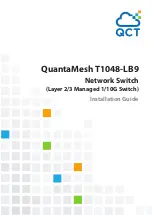
1-18
To do…
Use the command…
Remarks
Specify the reserved ports,
that is, the ports that will not
be disabled when the device is
in the recovery state
mad exclude interface
interface-type interface-number
Required
By default, no reserved port is
specified, that is, all service
ports will be disabled
automatically when the
device is in the recovery
state.
Failure recovery
When the IRF system handles a multi-active problem, it disables all service ports on the devices in the
recovery state except for the reserved ones. Failure recovery is to restore (
undo shutdown
) these
disabled service ports. The following two failure recovery approaches are available:
z
Auto recovery: The IRF system uses logs to inform the user to repair the IRF link. After the link is
recovered, the devices in the recovery state will reboot, and join the current IRF as slaves; the
disabled ports are automatically restored.
z
Manual recovery: If auto recovery fails due to exception (such as the current master device fails),
you can restore devices in the recovery state through command lines.
Follow these steps to manually restore devices in the recovery state to the normal state:
To do…
Use the command…
Remarks
Enter system view
system-view
—
Restore devices in the
recovery state to the normal
state
mad restore
Required
Accessing an IRF
Accessing the Master
After an IRF is formed, you can access the console of the IRF system through the AUX or console port
of any member device. Create a Layer 3 Ethernet interface, and configure an IP address for it, and
make sure that the interface and the user terminal are routable to each other. Then you can access the
IRF system remotely through Telnet, Web, or SNMP.
When you log in to the IRF, actually you log in to the master device of the IRF. The master is the
configuration and control center of an IRF. After you configure the IRF on the master, the IRF system
synchronizes the configurations to the slaves.
Accessing a Slave
When you log in to an IRF, actually you log in to the global active SRPU of the IRF. The operation
interface of the access terminal displays the console of the global active SRPU. After you execute the
irf switch-to chassis
chassis-number
slot
slot-number
command, the device can redirect you to a
global standby SRPU. After that, the user access terminal displays the console of the global standby
SRPU instead of that of the global active SRPU. The system enters user view of the global standby
SRPU and the command prompt is changed to <Sysname-Slave#member ID/slot number>, for
Содержание S7906E - Switch
Страница 82: ...1 4 DeviceA interface tunnel 1 DeviceA Tunnel1 service loopback group 1...
Страница 200: ...1 11 DeviceB display vlan dynamic No dynamic vlans exist...
Страница 494: ...ii Displaying and Maintaining Tunneling Configuration 1 45 Troubleshooting Tunneling Configuration 1 45...
Страница 598: ...ii...
Страница 1757: ...4 9...
Страница 1770: ...6 4...
Страница 2017: ...2 11 Figure 2 3 SFTP client interface...
Страница 2062: ...i Table of Contents 1 URPF Configuration 1 1 URPF Overview 1 1 What is URPF 1 1 How URPF Works 1 1 Configuring URPF 1 2...
Страница 2238: ...1 16 DeviceA cfd linktrace service instance 1 mep 1001 target mep 4002...
Страница 2442: ...2 4 Set the interval for sending Syslog or trap messages to 20 seconds Device mac address information interval 20...
















































